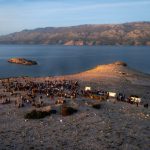Capital city of Istria, Croatia, Pula’s Roman heritage is second to none. Pula Arena is the best-preserved Roman amphitheater outside Italy and a national emblem. Brimming with history yet vibrant and forward-thinking, this is a city that’s alive among the relics.
- Welcome to Pula Croatia!
- Top 5 best things to do in Pula
- Pula Arena: all you need to know
- The best Pula beaches
- Where to eat: Pula restaurants
- Where is Pula Croatia? Pula Croatia Map
- Weather in Pula, Croatia
- Where to stay: Pula hotels, accommodation
- Top 4 day trips from Pula
- 3 things you (maybe) didn’t know about Pula
- How to get to Pula and get around
Welcome to Pula Croatia!
The capital of Istria, Pula is the top city destination of its region. An incredible mix of coastal and continental, ancient and modern. Its beachside location gives all the classic Mediterranean signs. Pristine beaches with crystal-clear seas, fresh seafood at every restaurant. And yet, this is not just another Mediterranean destination. Next to the seafood, you’ll find game meats, truffles and the world’s best olive oil. Furthermore, you can wash them down with incredible local wines like Teran and Malvazia. But, this is not strictly coastal fare. Actually, it’s the produce of inland Istria. The popularity of the region’s capital provides visitors with a rich showcase of the entire region.
Italy??
Pula Arena is instantly recognisable. Not only is it a symbol of the city and Istria, but also of Croatia. But, do you know about all of the fantastic Roman architecture left here? There’s much more than just the amphitheater. For that reason, it’s perhaps unsurprising that some actually confuse this as Pula Italy (really, they do).
However, it’s important to realise that this city is neither a monument nor a museum. Although empires like the Romans and Venetians left their mark, this is a city that belongs to today’s inhabitants. Full of culture, sport, art, ideas and events, Pula is vivid and vibrant. If you want to relax beachside, investigate nature and history, enjoy food and wine, or party, there’s a place for you here.

Top 5 best things to do in Pula, the best things to see in Pula
1) Roman heritage, the Arena and rich city history in architecture
If you’re looking for what to do in Pula, then the best advice is simply to take a walk around. Without a doubt, Pula is like no other city you’ll see. Pula Arena dominates the northern edge of the immediate city centre. It overlooks the waterside, impressively welcoming all who arrive on the Venice to Pula ferry.
But, the repute of Arena Pula’s stone arches extends far beyond the city and those arriving. Undoubtedly, it is a monument recognised globally. Accordingly, we’ve given this symbol of Pula its own grand section (underneath). However, Pula colosseum is far from the only Roman remnant in this city. Nor is it the only unique building. In detail, here are some of the best things to watch out for.
Double Gates (Porta Gemina) and the Gate of Hercules
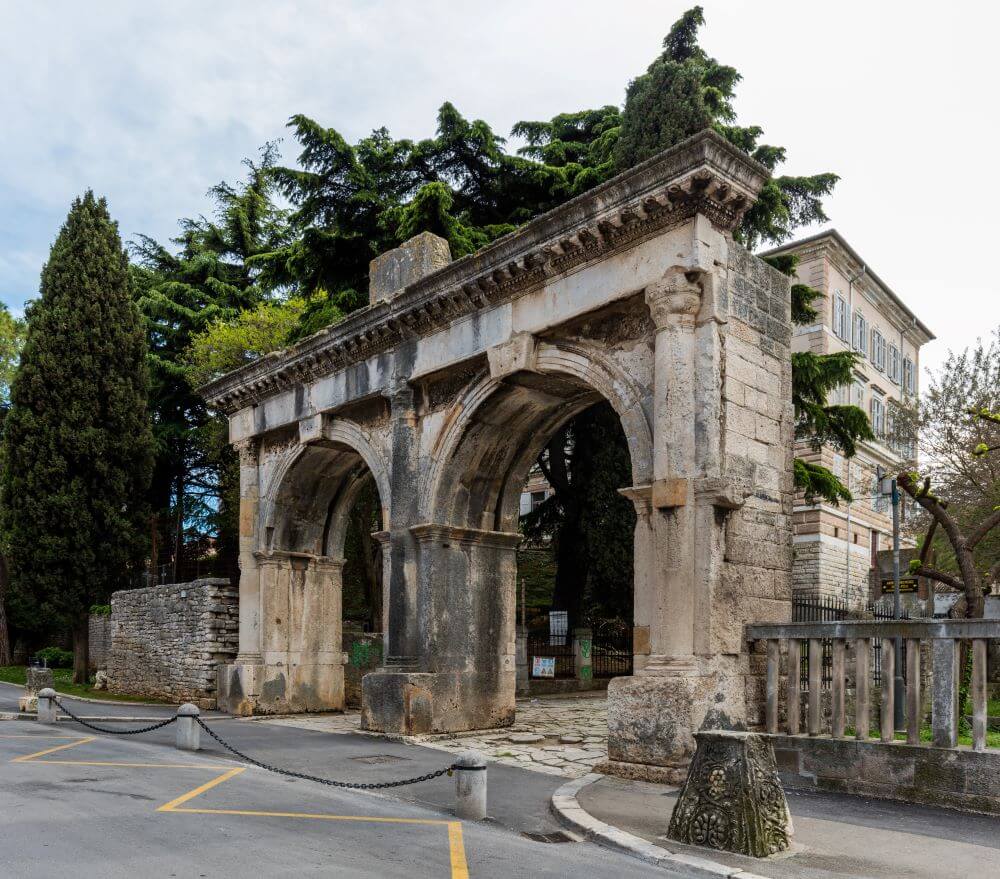
Between Tito’s park and King Petar Krešimir park, quite close to Pula Arena, you’ll find Carrarina street. Both the Double Gates (Porta Gemina) and the Gate of Hercules are here and you shouldn’t miss them. In fact, Porta Gemina are the best-preserved (and near only) remnants of the old city walls. They date from the second century. Passing through the gates you’ll see a Roman tunnel, renovated over recent years. Furthermore, you can now go inside.

Although the Gate Of Hercules is less grand, it’s actually even older than Porta Gemina. Significantly, it features markings indicating Pula’s foundation as a Roman colony as far back as 47 BC.
Temple of Augustus in Pula

In the same way it always was, Pula Roman Forum is the centre of city life. By day, people meet for coffee, by night teenagers and children happily hang around. Notably, in summer, they’re often serenaded by musicians or theatre.
Previously, three temples stood around this central point. However, Temple of Augustus Pula is the only one that now remains. In fact, it is incredibly well preserved. Indeed, it is considered one of the finest outside Italy. What’s more, you can even go inside.
The Arch of the Sergii

To get the true essence of Pula, there’s one unmissable route to take. Actually, it circles around the city centre hill and fortress. After Pula Arena, follow Amfiteatar street (Amfiteatarska ulica) between the two small parks. Subsequently, you’re on the atmospheric Kandlerova street. Presently, this leads down to Pula Forum. Thereafter, the street becomes Sergijevaca. Actually, it’s named after the most impressive monument on this section of the route.
The Arch of the Sergii in Pula is a triumphal arch that once served as entrance to the city. Named after the Roman family who built it, the arch commemorates their successes in the Battle of Actium (31 BC). Indeed, they must have built it to last, because it’s incredibly well preserved. In particular, look out for the spectacular carving of an eagle as you pass underneath.
Hidden Roman and Illyrian heritage

Kažnjavanje Dirke
Generally, Pula’s Roman artifacts come in two sizes – huge and pretty small. Among them, Kažnjavanje Dirke is unique. Actually, measuring some 12 metres by 6 metres, this incredible mosaic couldn’t be considered small. However, its extraordinary provenance and rediscovery doubtless explain its preservation. Built between the 2nd and 3rd century, for hundreds of years it lay hidden beneath the streets of Pula. It was uncovered by bombing during World War II. Although, it’s actually still a little hidden, next to a car park off Sergijevaca. Find it at Sergijevaca 16 (you still might have to ask a local, or use your phone).
Nesactium

If you’re looking for history here that pre-dates the Romans, then head out of town. Specifically, 10 km north-east, just past Pula Airport, you’ll find Nesactium. Significantly, this was the main settlement of the Histri tribe after who the whole region is named. Sadly, the Romans destroyed it and made a new town on the site. However, theirs fell into ruin after the fall of the empire. Both Istrian and Roman remains can now be seen here at the archaeology park.
Pula Venetian Fortress (Fort Kaštel)

Actually, Kandlerova/Forum/Sergijevaca is not the only route to ring around the city centre. Indeed, there’s one even more central, encircling the hill and fortress atop. Markedly, Castropola is much more of a climb. Indeed, you should take care not to make the journey on foot in the middle of a hot summer day. Or, take the car. When you near the top, you’ll first find the old, outdoor Roman theatre (Malo Rimsko Kazalište). Actually, in warmer months, performances still take place here. Afterward, you reach the Kastel, a 17th-century Venetian fortress with star-shaped defensive walls.
The best view in Pula
First thing to remember is that this upwards trek is work making for the views alone. Not only are the fortress, walls and open-air theatre worth seeing, but also the superb city-wide vista. You can see Pula colosseum, the bay and its island and the cranes on the docks. Unquestionably, it’s the best view in Pula. What’s more, it’s the BEST vantage point from where to catch city fireworks. For instance, those of New Year’s Eve.
However, Pula Fortress is in such great shape for a reason. Specifically, it was reconstructed in 1955 to house the Historical & Maritime Museum of Istria. You can read up about it in our museums’ section below.
2) Explore the big blue: beaches, dolphins, aquarium, boats, canoes

Beaches in Pula are an essential part of any visit to the city. Certainly, the city is better known for its history and heritage than for its beaches. But, if you’re spending a few days here during warmer months, you’ll want to cool off in the big blue. Furthermore, you’ll want to know which Pula beaches are the best. (Because that’s not immediately apparent from the centre of town.) To that end, there’s a dedicated guide to Pula beaches (directly underneath).
However, beaches are far from the only way to experience the Adriatic here. Indeed, Pula’s offer for enjoying the sea is quite different from most places in Croatia.

Discover Adriatic residents at Pula aquarium
Kids got sunburned and you need to stay inside but keep them entertained? A rare rainy day? Then the city aquarium is a great option. Point often overlooked is the aquarium is a good few hundred metres walk from the free car parking and the bus stop. Therefore, please have this in mind if you’re going there with very young children.
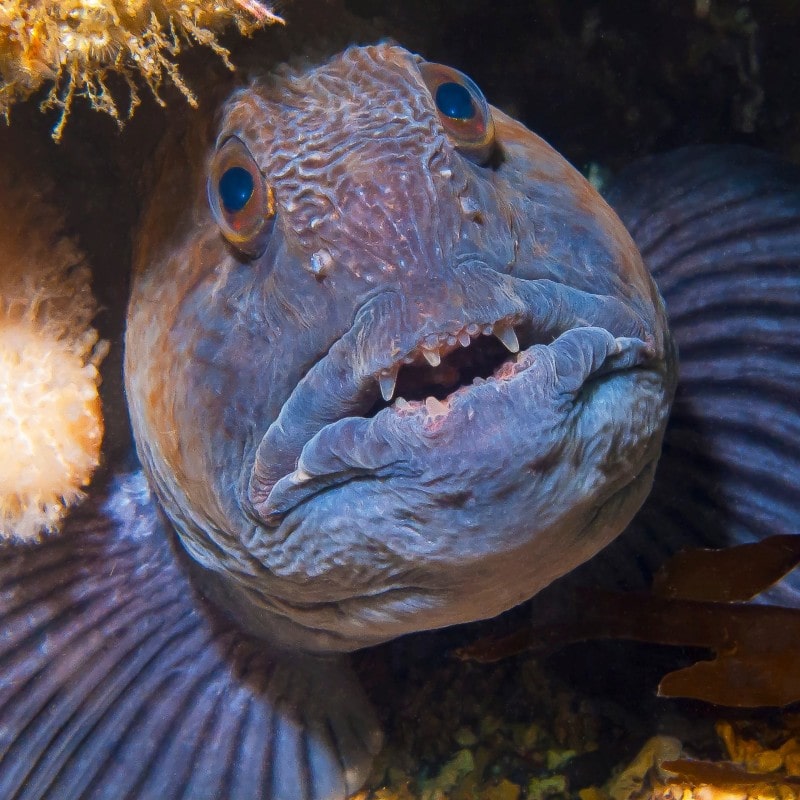
The 19th century Fort Verudela hosts the aquarium. Owing to its position, 31 metres above sea level, views from the roof are great! Inside, a three-floored, well laid out aquarium presents regional species in small to moderately sized tanks. Although there are no undersea tunnels here nor giant residents, there’s enough variety and accompanying info to keep the curious interested for hours. In detail, over 200 species of marine and freshwater fish, reptiles and amphibians live here. If you’re planning to go with a wheelchair user, telephone in advance to ask what provisions they have in place. Another good tip is to check the entry fee before you go. While some consider it quite expensive, others think it good value for what you get.
Remarkable journeys by boat, canoe, paddleboard and underwater

The coastline around the city isn’t always the typical gentle slope into the sea of the beach. In fact, at many points, rocky cliffs drop rapidly down into the water. Furthermore, these cliffs obscure hidden coves, beaches and caves. Subsequently, it’s a topography perfect for exploring.

Take a guided tour of islands, cliffs and caves with Kayak centar Pula from the south tip of Verudela or Gole Sport Kayak from the north tip. Not only do Pula Kayak rent their boats for undirected excursions, but they’ll also drop them off at the start point you choose. Alternatively, if you’re looking for underwater views, try Orca diving centre, also on the southern tip. Metta Float sees similar sights to the kayak tours, only this time you’re on stand-up paddleboards. Additionally, there are boat trips available from almost all points of the city coast. While some will take you around the coast’s cliffs, caves and lighthouse, others go to Brijuni, some will take you snorkelling and others will guide you to dolphins.
Go dolphin watching

If you’re asking how to see dolphins in Pula, the best answer is to take a guided tour. Basically, local boat operators know these waters and the dolphins better than most. Furthermore, they’ll have made many such excursions in the past.
Actually, there are a wealth of options for seeing dolphins in Pula. Not only are there family-friendly trips, but also there are some including wine and dinner. For the most part, warmer month trips occur late in the afternoon or around sunset. However, when the water finally cools in late autumn and winter, activity times open up. In fact, during these times of the year, it’s possible to see dolphins at any time of the day. What’s more, if you’re lucky, you might even catch sight of a whale too.
3) Kandlerova

It’s all very well getting up close to architectural heritage. However, this city is not a museum, its cultural, social and artistic life continues. As can be seen on and around the street known as Kandlerova. Admittedly, in the height of summer, this stone-paved thoroughfare becomes a main artery for visitors. However, this is no tourist trap. In fact, this area has been important to the city’s expression for arts & crafts and unique, independents for a long time.
Very much like the people found along it, the partially shaded street ambles its way through the city. It passes boutique shops, galleries, bars and informal restaurants with outside seating. Furthermore, it’s wonderfully atmospheric and a real slice of the contemporary. For instance, with libraries, bookshops and a publishing society here, it’s a hub for the city’s modern-day literature scene. What’s more, during usual summer months, stalls are set up behind St. Thomas Square. Here, you can buy traditionally made produce, arts & crafts.
4) Events

Time was when this city was known mostly for its connection to antiquity. However, after 2010, the city became one of Croatia’s most-searched places on Google. Why? Unquestionably, the arrival of two British electronic music festivals. With a huge international reach, they helped the city become famous to a young, new generation. Eventually, these festivals succumbed to the challenges of holding events at the remote Fort Punta Christo. Subsequently, they downsized and moved to Tisno, Dalmatia. But, fantastic events here did not begin and end with the comings and goings of the Brits.
At the same time Brit festivals held concerts at the Arena, so too did others. As a matter of fact, globally recognised artists from the worlds of opera, classical, rock, pop and world music performed here. Alternatively, the city hosts Croatia’s oldest punk festival. Actually, it’s a remnant of the times when the city incubated exciting Pan-Yugoslavian rock music. Additionally, Croatia’s first festival of lights, Visualia Festival, is here (more about that below).

In any normal year, events in the city spill out into the streets. Not only will you hear music and see theatre on the Roman Forum, but Roman reenactments there and in the colosseum too. All of a sudden, events in the city ground to a halt in 2020, as everywhere. However, there are signs that things are tentatively returning. In brief, the current most up-to-date info of what’s on is detailed by the city tourist board website.
5) Museums and galleries
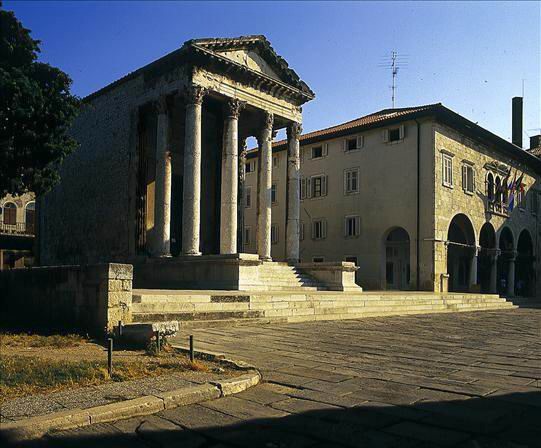
After walking the city taking in ancient architecture, more old stuff isn’t for everyone. Particularly some kids. However, if history and heritage has prompted your visit, the city has a lot to offer indoors as well.
Previously mentioned, the Aquarium pleases many. Also, the Venetian Fortress (Fort Kaštel) contains the Historical & Maritime Museum of Istria. Specifically, it takes a look at regional history. In detail, it covers the city, its port and the impact of the numerous empires that have ruled here.
Relatively speaking, Memo museum offers a more contemporary view of life here. Specifically, they have fascinating items from the last century including vintage cars, computers and furniture. By comparison, Galerija Makina near Kandlerova is much more up-to-date. Actually, it’s the city’s go-to spot for contemporary photography exhibitions.

More museums
Although much of the content is specifically aimed at locals, it’s worth keeping an eye on events at the Rojc community center (Rojcnet). In detail, they host exhibitions, films, talks and conferences. Not only does the Archaeological Museum of Istria hold many Roman artifacts, but also Illyrian, medieval and Bronze age. Specifically, it has glass, pottery and sculpture.

Formerly a printing works, the building which currently hosts Museum of Contemporary Art of Istria (MSUI) may not do so forever. In fact, MSUI’s four permanent themes and visiting exhibitions are due to move also to the Venetian Fortress. Graphic design, photography, film, contemporary local and foreign art are all housed here. Also worth acknowledging the House of Istrian olive oil, Museum Gallery Sacred Hearts (Sveta Srca) and the collection by prolific painter Antun Motika, held at the Istrian National Theatre Gallery.
Pula Arena: all you need to know

Built in the 1st century AD, Pula colosseum is the best-preserved outside Italy. Actually, it was built at the same time as the colosseum in Rome. Not only is it one of the six largest remaining Roman arenas, but also the amphitheatre in Pula is Croatia’s best-preserved ancient monument. The shading sails that used to fly overhead are no longer in situ. Indeed, in ‘full flight’ the venue must have looked incredible. Its ability to awe remains. Undoubtedly, it is a symbol of Pula, Istria and Croatia itself. Furthermore, no trip to Pula is complete without visiting it.
Arena Pula
Since the Romans built it, Pula coliseum has been an immense part of the city’s make-up. Indeed, so large was the imposing structure that it actually had to be constructed outside the city walls. Although, with its fearsome gladiators and animals, perhaps only the foolish would attempt an attack? Today, instead of Pula amphitheater, it is popularly known as Pula Arena.

When can you visit Pula Arena? Pula Arena opening times
If you’re taking children, then the best time to visit Pula Arena is morning or when the day cools. Because, there’s no shade in the central space. Alternatively, just go visit outside of midsummer, it’s open almost every day.
November – March, 9am – 5pm.
April + October, 8am – 8pm.
May + September, 8am – 9pm.
June – August, 8am – 10pm
Where is Pula Arena located
If you’re looking for how to get to the colosseum, Pula Arena is located on the northern edge of the city centre. Specifically, it overlooks the city port and bay. In detail, its GPS coordinates with respect to latitude and longitude are 44.8738° N, 13.8500° E

Pula Arena Croatia today
One of the best things about Pula colosseum is that its legacy continues. While local efforts have ensured it remains one of the best-preserved Roman amphitheatres in the world, it is still an active hub for the city’s art and culture. Stars from the worlds of opera, classical, rock, pop and world music have performed here. Specifically, Luciano Pavarotti, Elton John, David Gilmour (Pink Floyd), Massive Attack, Grace Jones and Sting, to name just a few. What’s more, it’s the host site for a longstanding and significant film festival.
Pula Film Festival
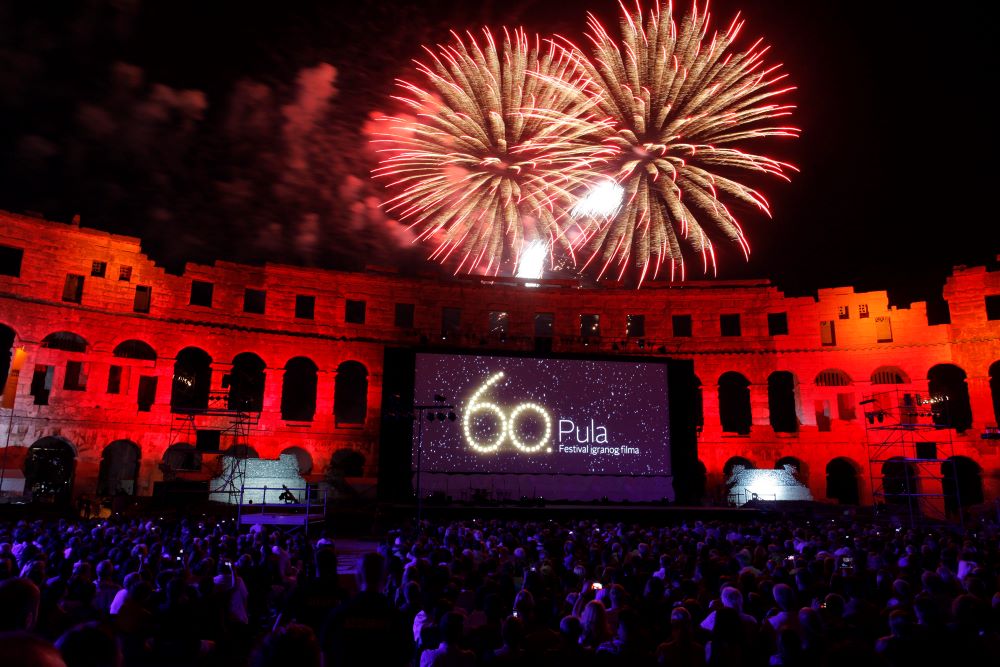
Established in 1954, Pula Film Festival once attracted global megastars like Sophia Loren and Elizabeth Taylor. These days, though still very prestigious, the glitz and glamour take second place to movie making and the films themselves. For the most part, the world-famous attendees are now film directors and lead actors. Without doubt, it remains one of the most important film festivals in Croatia and the wider region.
Verudela

Important to realize, many of Pula’s best beaches and water activities are located on Verudela. To clarify, Verudela is not in the centre. Although, it isn’t far at all. In fact, Verudela is a peninsula that lies just to the south of the city centre. So, if you’re looking to hit the waves, you need to know where is Verudela and how to get there. Not only does it have some key hotels, the aquarium and some of the best city beaches, but also an aquapark, windsurfing, canoeing, parasailing, segway, diving and activities by boat.
How to get to Verudela, how to get to Pula aquarium, how to get to Pula beaches by bus
To get to Verudela, you’ll need to take a bus, bicycle or car (unless you’re actually staying on Verudela). To get to Verudela by car, aim for Veruda ulica or Ulica Prekomorskih brigada, running south (‘ulica’ means street). Both will take you to the roundabout where you turn off for Verudela and you can take these routes on bicycle. There are several free parking points on the peninsula. However, it’s very difficult to direct you to any because almost every stretch of road on the peninsula is simply called Verudela. Subsequently, using your phone map is best.
Verudela bus
To get to Verudela by bus you need the 2a or the 3a from the city centre. Both leave from the bus station and also pass by the city centre. However, they take different routes through the city. Therefore, take either from the station or first do your research. To that end, we’ve provided maps of local city bus lines. Find them in the ‘How to get to and get around’ section, below.
The best Pula beaches

Of Croatia’s three coastal regions – Dalmatia, Kvarner and Istria – only the latter is a peninsula. Subsequently, unlike the other two, its coastline has no main direction of travel. Indeed, while large sections of Kvarner and Dalmatia shoreline run straight, following the coast’s north-west to south-east flow, Istria’s definitely doesn’t. Markedly, it twists and turns in every direction. Another key point, there are no Dinaric Alps here, no millennia-old rise from beach to mountain. Rather, while Istria’s coast does have beaches gently rolling into the sea, also sheer rock faces plummet down. So too, hidden coves, caves and multiple bays. Overall, in a similar, varied display, Pula’s coast is typically Istrian.
Brilliant beaches run along the coast in every direction from the city. As a matter of fact, some visitors, unaware of local geography, often mislabel them. In detail, they’ll often refer to beaches in altogether different municipalities as their ‘favourite beach in Pula’. Certainly, it’s true to say that Općina Fažana, to the city’s north, and Općina Medulin, to the south, have amazing beaches. But, to label them as ‘Pula beaches’ does these municipalities a disservice. And, besides, to detail their beaches too would require a book. Therefore, below are the best beaches in Pula city limits, broken down into three main areas.
Verudela beaches

The most southerly of the city’s three headlands is vacation central. Both close to the city and easy to reach, it has great beaches. In response, it’s long been a place for holidaymakers. Not only are there traditional resorts, apartments, but also several hotels including very nice 4-star options. However, don’t feel you’re intruding if you access the beach through the grounds of any. Because the sea is for everyone. The immediate north-west is devoted to the unfussy and convenient Golden Rocks resort (Zlatne stijene). On the other hand side, the north-east is given over to an extensive marina.
Beaches on Verudela

Ambrela beach
The Blue flagged Ambrela beach has a small pebble shore. Also, changing facilities, showers, loungers, umbrellas, toilets, cafe bar and pedalos. Actually, this is the beach closest to Verudela bus stop and the most southerly of Verudela’s free parking. Subsequently, this is both a great beach for a family and a sometimes very popular choice. Want a little more seclusion? Just head a little further south.

Hawaii beach (Havajska plaža)
Notwithstanding the absence of ukeleles and flower necklaces, Hawaii beach (Havajska plaža) does feel like an idyllic island paradise. Not only is it secluded and surrounded by shading pines, but also this small beach is great for catching the sunset. If you’re looking for a quieter spot, move away from the pebble beach area and onto the rocks. Actually, some young people love to clamber up and plunge into the water below.

Histria beach
Both Hawaii and Histria beach are located on the southern tip of Verudela. Therefore, they share some similarities – secluded, small, very clear waters. By the same token, there are some distinct differences. Consequently, you need to ask yourself what exactly you want from the beach. In detail, Histria is fantastic for catching the sun in the first part of the day. However, it falls into shade quite early. On the positive side, this means the beach becomes less crowded. Furthermore, it’s the perfect spot to go if you’ve already had a little too much sun.

All of Verudela’s beaches are near resorts or hotel complexes. Subsequently, all are serviced by nearby cafe bars or restaurants. However, if you’re on a budget, just pack a picnic. Furthermore, the south-eastern shore near Histria has Betina massage therapy. Under the shade of long flowing, light canopies that flutter in the breeze, aromatherapy oils and qualified masseurs relax both body and mind.
Štinjan beaches
Formerly the host site for electronic music festivals, Štinjan was a holiday spot long before their arrival. Holiday homes, camps and apartments to rent lie inland. From there, it’s a walk down to great coastal walks and the beaches.
Proština beach is the most remote, right at the tip and is quite rocky too. On the positive side, it has clear waters, is uncrowded and has interesting features. Specifically, a lighthouse and a rope bridge.
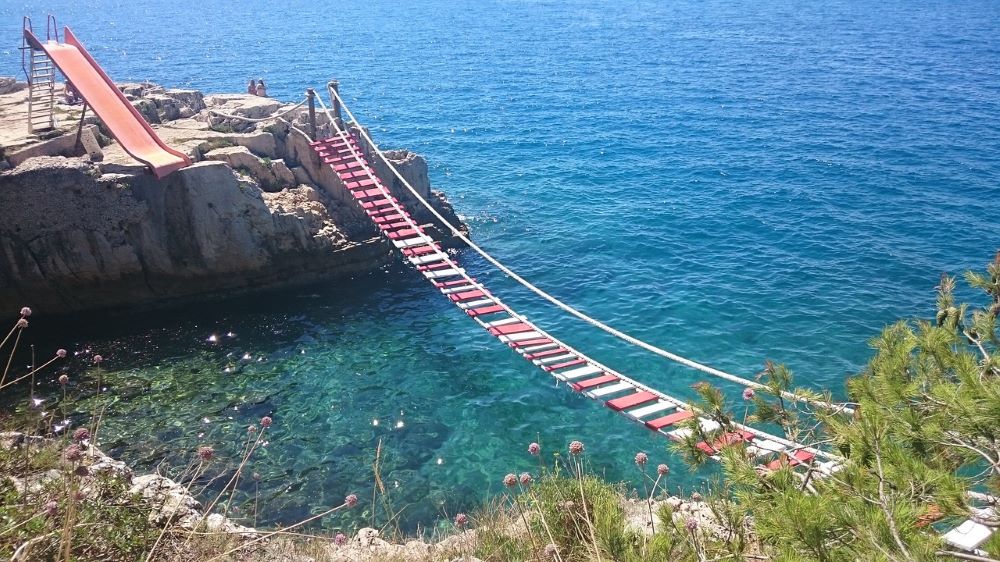
On the east, Lost beach is easier to reach from where you leave your car. Not only is it small and uncrowded, but also the waters are clear and it’s good for sunsets. By comparison, Vile beach (Plaža Vile) has lots more amenities than the other two. Specifically, there’s a beach bar, bistros and even a bakery near the campsite. Additionally, a little further south there’s a section for naturists.

Stoja beaches

The headland to the west of city neighbourhoods Monte Zaro and Veruda we’ve called Stoja. This land outcrop forms the south of Pula bay. Subsequently, only the beaches on its south side are used. In detail, these beaches are closest to Pula city centre and face the more southerly Verudela headland.
Not easy, rocky, but youthful, quiet and rewarding
Both of the most westerly beaches, Stoja and Seagull’s Rocks (Galebove Stijene) are not easy to reach and are rocky. Furthermore, the waters here are best accessed by leaps into the sea. Therefore, they can only be recommended to those who are active and fit. Important to realize that this distinct landform does have bonuses, like the spectacular Galeb cave. In fact, you might visit it on some of the organised kayak/canoe trips.
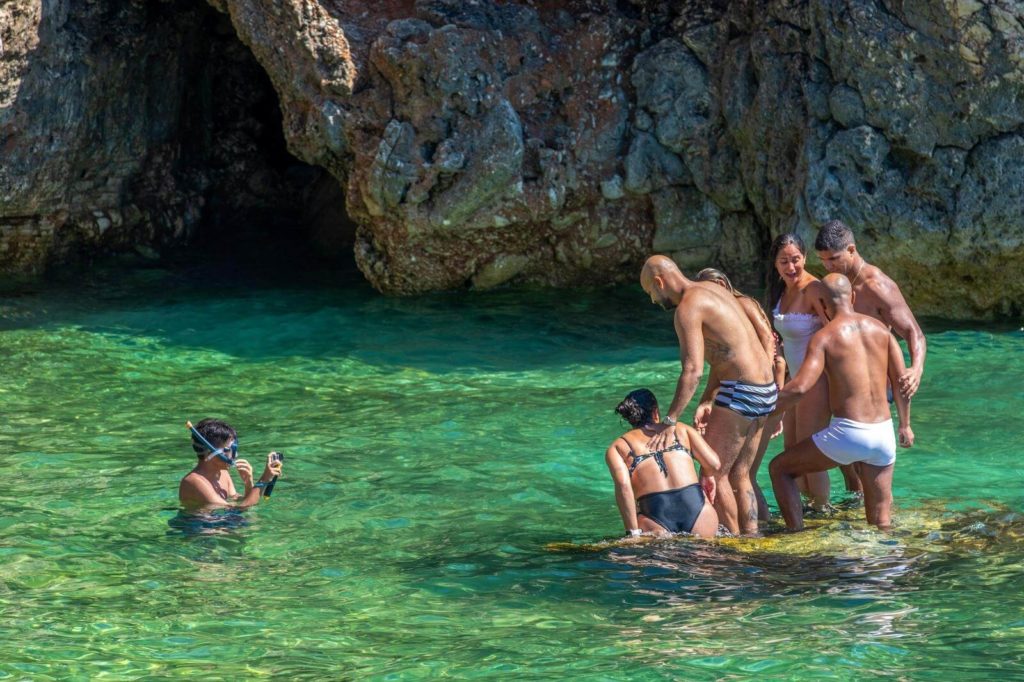
Just to the east, Cyclone beach (Ciklonska plaža) is small, easier to reach and usually not crowded. However, access and the beach are still rocky, so not for the kids. Comparatively, Fižela beach is accessible and quiet, but still very rocky, as is Valovine beach. The beaches on the Stoje peninsula itself service the popular nearby camping grounds. They are of a similar rockiness. In particular, the area at the southernmost tip is great for snorkeling, with interesting rock formations.
Slightly easier

Zelenika beach is quiet and still rocky, but very accessible from the centre. Also, Valkane beach, to the east, is a little more manageable. Additionally, it’s serviced by bars and food outlets, plus showers, toilets and nearby tennis courts.
Cycling in Pula: Lungomare, your unmissable seaside route

The headlands of Stoja and Verudela are connected by a shoreline road, Lungomare. If you’re taking a bus to the beach in Verudela, then you’ll miss it. But, if you’re on a bicycle, eschew all other, maybe quicker routes to Verudela. Without a doubt, this is the one for you. Not only do you pass right next to the sea, but also you get amazing views of Stoja and Verudela. In fact, bicycling in Pula is a great way to get to most beaches.

Valsaline beaches

If you want to dash out of the city after work to cool off, then Mornar beach is a convenient, unfussy choice. Certainly, that’s how some locals use this beach, some walking there, others using the available car park. Also, it’s serviced by a small, similarly unfussy cafe. If there’s a midsummer evening when the heat just doesn’t want to leave the city, then also you might find people here. Because it’s an easy spot to chill after dark. Likewise, Valsaline beach itself has car parking and a beach bar. Given that there’s a hostel nearby, the beach can sometimes be quite youthful.
Where to eat: Pula restaurants
Given that people walk Pula’s centre all day, there are multiple street food and fast food options here. Indeed, some are a cut above the norm, so ask a local to recommend. Although some restaurant menus are reassuringly seasonal, fresh seafood in the city’s best restaurants is a given.
Restaurants in Pula

Looking for fine dining at dinner? The formal and refined Milan Hotel restaurant and the gastronauts fave Farabuto are good choices. Not only does the latter have a strongly seasonal menu, but also both are in Veruda.
Both the decor and menu at Vodnjanka in Monte Zaro are homely and traditional. Not only does this informal eatery cook seafood well, but also game meats from inland. Ribarska Koliba on Verudela has a good reputation for seafood and next-level views of the marina. By comparison, Kantina in the centre is more informal, yet with very well cooked and presented food. Gina in Stoja has a nice ambiance and extra sea views. Additionally, Konoba Boccaporta does traditional meals well, and locals love the very casual and inexpensive Kod Kadre.
Where is Pula Croatia? Pula Croatia Map
Pula is located in the northwest of Croatia, on the southwestern tip of the peninsula Istria. It is a coastal city. In detail, its GPS coordinates with respect to latitude and longitude are 44.8666° N, 13.8496° E. And the Pula zip code is 52100 Pula (postal code).
Pula weather Croatia
Weather in Croatia Pula is mild and pleasant throughout the year. In detail, the summers are long and warm, but rarely too hot or too dry. Also, the winters are never too cold. Wondering about the weather in Pula in May? Pondering the Pula weather in October? Doubtless, Pula out of peak season is a peaceful and pleasant time to visit. Here’s how the weather in Pula looks today and for the rest of the week.
Where to stay: Pula hotels, accommodation
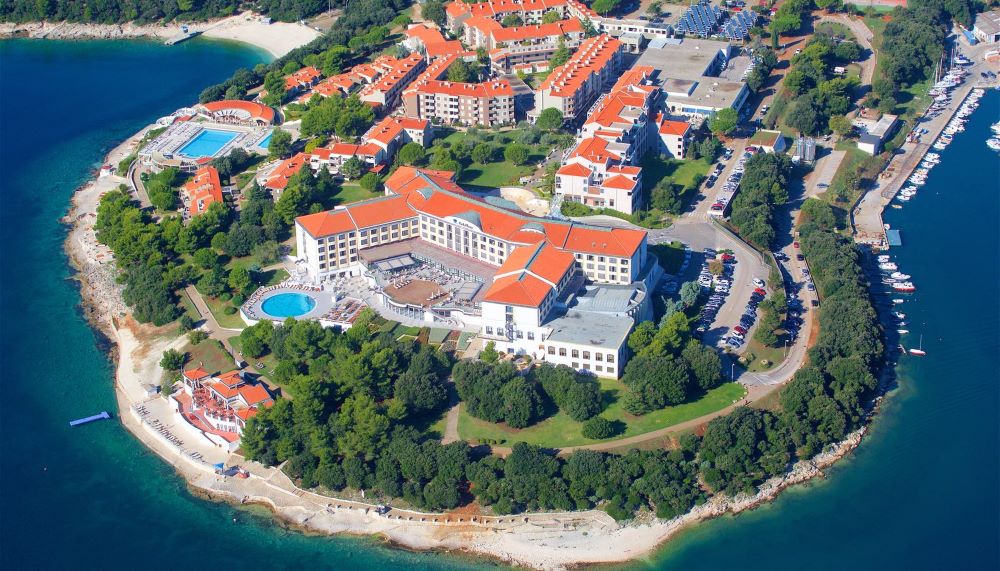
Whatever specific kind of accommodation you’re looking for, Pula has it. Camping Pula is a terrific option and there are lots of choices. Villas, apartments and holiday homes tend to be out of the centre. Looking instead for hotels in Pula? There are many, with the 4-stars on Verudela being highly rated. Check all the options on the usual booking platforms.
Top 4 day trips
Venice

Unsurprisingly, both Pula and Venice come high on bucket list vacation destinations. Subsequently, the ferries Venice to Pula and ferry Pula to Venice are incredibly popular. Actually, two operators have options of a Pula to Venice ferry. Additionally, several tour operators offer tickets and guided day trips from Pula to Venice.
How to get to Venice from Pula by ferry

When you can get a ferry from Pula to Venice: timetable
Adriatic lines usually run their return service ferry between Pula and Venice during May, June, July, August, September and early October. On this line, there are more Pula Venice ferries in July and August. You can contact them for 2021 timetables, prices and tickets here. You can contact Venezia Lines to ask about their 2021 timetables and prices for Pula to Venice ferry here
Where to get the ferry from Pula to Venice
Pula ferry port is located at Rijeka Pier, Ulica Svetog Petra, 52100 Pula, Croatia. Specifically, where the ferry port Pula is: GPS coordinates with respect to latitude and longitude, 44.5229° N, 13.5053° E
How long does it take to get from Pula to Venice by ferry?
The average journey time by ferry between Pula and Venice is 3 hours and 30 minutes. Journey times do vary, so check in advance. Although the journey time may seem long, ferry and tour operators are aware that many wish to make only a day trip to Venice from Pula. Accordingly, early morning ferries to Venice from Pula are available. Additionally, you can buy same-day return tickets for Pula Venice ferry. Furthermore, there are guided tours which will ensure you see the sights and get the ferry from Venice to Pula in time.
Tickets: Pula Venice ferry
You can buy Pula Venice ferry tickets online or from Pula ferry port. In addition to buying direct from the ferry companies, several tour operators also offer tickets and accompanied journeys. You can contact Kompas Travel to find out their offer for 2021 here
Brijuni

Most of the 14 islands of Brijuni are off-limits to the public. Subsequently, if you don’t want to take the official tour of Brijuni National Park, you’re looking at a sea cruise only. Actually, these are interesting and fun. Because it’s a singular set of islands worth investigating. However, it’s also well worth visiting Brijuni National Park.
Veliki Brijuni is the largest island and has beautiful parkland surrounded by the sea and trees. Furthermore, there’s a golf course, bird sanctuary, botanical gardens, zoo, safari park, three museums and dinosaur footprints.
How to get to Brijuni from Pula
The islands of Brijuni archipelago and Brijuni National Park are just a 15-minute boat journey from Pula. However, to get the boat from Pula to Brijuni, you have to go to Fažana, just north of Pula. To get a bus from Pula to Fažana, go to Pula bus station and look for the number 21 bus. You can contact the bus operator and check for the summer timetable here.
To visit Brijuni by boat from Fažana, you must first buy a ticket for Brijuni National Park in Fažana. The ticket office is on the quayside. The ticket includes boat transfer between the mainland and Brijuni, entry to the National Park and a guided tour on a little train. Including the boat journeys, the trip to Brijuni takes about four hours.
Inland Istria

Exploring inland Istria is one of the most rewarding things you can do in Croatia. Not only is it a beautiful landscape of vineyards, villages, olive groves and hilltop towns, but also it’s a cultural and gastronomic paradise. How to get to inland Istria from Pula? Well, first do your research. Just what do you want from a trip into the interior? Whether you’re curious about Istria’s fine wine, truffles, olive oil or distinct cuisine, you can take a tour of any. Furthermore, there are unmissable annual festivals of food and culture. Want to eat the largest asparagus omelette ever? Hear jazz or watch movies open-air in the hills? Alternatively, maybe the kids want to visit one of Croatia’s best waterparks? Certainly, you’re never stuck for choices in inland Istria.
Opatija and Rijeka

Both Rijeka and Opatija are outside of Istria, in the Kvarner region. But, they’re not very far at all. Actually, it takes 1 hour 30 minutes from Pula to Rijeka by car. And, it takes less than 3 hours to get to Rijeka from Pula by bus. Furthermore, the bus route is a scenic one, running along the coast. Buses to Rijeka from Pula go from Pula intercity bus station, buy tickets there. Important to realize that all buses taking the coastal road also go through Opatija. However, you should check first. Because some buses from Pula to Rijeka actually go instead through inland Istria.
Your reward for choosing this day trip is two neighbouring destinations distinctly different from anywhere else. While Opatija is an opulent town, full of fine parks and Austro-Hungarian architecture, Rijeka is a big city. Accordingly, it has all the great attractions one holds. If you’re looking for nightlife, museums, culture and shopping, then this is a great choice. You can read more in our Rijeka guide and our Opatija guide.
3 things you (maybe) didn’t know about Pula
James Joyce lived in Pula (briefly)

One of the most influential and important writers of the 20th century, Irishman James Joyce, spent time in Pula. Specifically, he and his lover spent the winter of 1904 here, Joyce teaching English to soldiers. As a matter of fact, there’s a statue of him outside a cafe in the city centre. Furthermore, the cafe is named ‘Ulysses’, after Joyce’s most famous work.
People party and gather in air raid shelters here
Formerly a series of tunnels built as air-raid shelters, Zerostrasse now serves a different purpose. Specifically, it’s an event space for exhibitions, cultural gatherings and parties. Not only can you hang at a hip happening, but you can also shake off the heat in the tunnel’s cooler temperatures.
Illuminated city: Lighting Giants and Visualia Festival

At nine years of age, Visualia Festival is the oldest festival of lights in Croatia. Not only does it transform the entire cityscape, but its surrounding events filter through multiple Pula venues. Educational, artistic, inspiring and interactive, this festival justly draws folks from all over. In fact, in 2015, more than 4,000 visitors formed here the world’s largest human torchlit image. Cast in the city’s signature colours of green and yellow, it read ‘Pula + Istria’. Want to see the harbour cranes lit as never before? Or see historic buildings come to life via video mapping? This spectacular is for you.
How to get to Pula and get around
Pula airport: flights, where it is, how to get there, bus, car

The city has its own airport. You can now fly to Pula from many international destinations. Flights to Pula are also often very inexpensive, as several budget airlines use Pula airport. Furthermore, from the airport you can travel Pula Zagreb by plane and Osijek and Split too. Flights from Pula to Dubrovnik require a change of planes in either Split or Zagreb. You can read all about Pula airport in our dedicated page.
Road: by car

The city is extremely well connected by road. For Ljubljana to Pula, head for Koper, then take the E571. From Trieste to Pula, do the same. To travel from Rijeka to Pula, the quickest route is the E571 again, through inland Istria. From Zagreb to Pula, first take the E65 to Rijeka.
Looking for a fast, reliable and trouble-free transfer to or from Pula? Contact TC transfer partner Adriatic Transfers for your one-stop solution.
Pula rent a car
Looking to head to inland Istria or explore the wider coastline? There are lots of places to rent a car in Pula. Ask a local recommendation or the tourist information centre.
Boats: Pula to Venice ferry, Zadar to Pula via Mali Lošinj and Silba
For more details on to get to Venice from Pula by ferry, please see the day trips section above. In addition to routes from Pula to Italy, there’s another boat from Pula to Zadar via Unije, Susak, Mali Lošinj, Ilovik and Silba islands. You can find out more about this line here.
Pula bus: intercity and local

Intercity
Travelling intercity by bus in Croatia is a fast, popular and reliable option. Indeed, you can easily get to Pula by bus from anywhere in Croatia. Learn more about travelling through Croatia by bus here.
Local bus Pula: Pulapromet
Run by Pulapromet, local buses in Pula are reliable, frequent, safe and inexpensive. In detail, here’s a map of Pula inner city bus lines. Specifically, these are the buses to Pula beaches.

Additionally, here’s a map of Pula suburban bus lines. Specifically, these are the buses for Medulin, Fazana and Brijuni National Park. Also, you can reach nearby inland Istria and get to Pula airport.

More information
For more information, you can see Pula Tourist Board at pulainfo.hr. Additionally, the Tourist Board of Istria here.
To follow the latest news from Pula, check out the dedicated TCN page.







